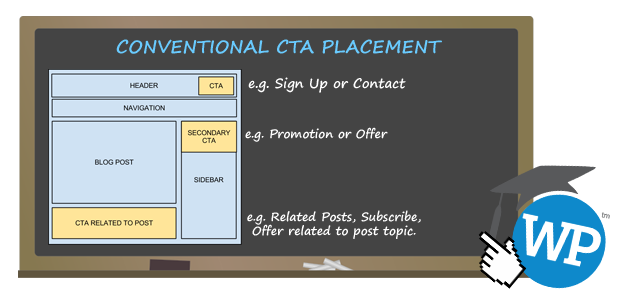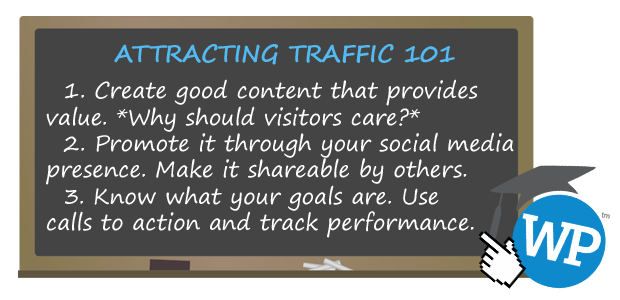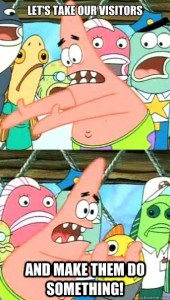
This series has been dedicated to bringing traffic to your site. And while that’s great, we have to ask – what’s the point? Why do you want that traffic? What are you going to do with it?
Creating content with your own objectives in mind is just as important as creating content that fulfills the needs of your audience. Today we’ll look at setting goals for your content, how content can support those goals, and how you can measure those goals using WordPress plugins.
What are your goals?
Regardless of what your website is about, you should have goals in mind.
Let’s take three different types of WordPress websites as examples: an artist’s portfolio, a professional services business, and a mommy blog.
What are the goals for their websites? The artist wants to sell prints of her work. The business wants new sales leads. The mommy blogger wants to grow her audience.
These aren’t their only goals, though. The artist also wants to promote her upcoming shows or galleries that she’s appearing at. The business wants to provide support for current customers through the website. The mommy blogger wants visitors to read more content.
Setting goals is important. Make a list of goals for your website. Prioritize them.
Include clear calls to action.
You have content pulling people to your site, and you know what your goals are. Now it’s time to connect the dots with Calls to Action (CTAs). CTAs are visual cues for your audience to do something, like sharing a blog post, making a purchase, contacting the sales team, or subscribing for updates.
Make it easy for your visitors to take an action. Conventional layouts work because they don’t make a visitor struggle to figure out where things are. Your calls to action should be placed in an obvious spot, and make sense given the context of where they appear.
Don’t overdo it. Use too many calls to action and you’ll shoot yourself in the foot. It’s distracting, overwhelming, and you’ll make your CTAs compete against each other. Stay focused on one primary call to action per page with secondary, complementary CTAs sprinkled throughout.

Use the right tools to track your goals.
You have your content, you know your goals, and you have your calls to action pushing visitors towards your goals. Great! Now we need to make sure those goals are being monitored, and that we’re keeping an eye on the metrics associated with the goals.
We can accomplish this with the use of plugins. Let’s turn back to our three examples: the artist, the business, and the blogger.
The artist wants to sell her work online. While she could put a phone number on her site and take orders that way, she should be using an e-commerce plugin like WooCommerce to take orders directly on her site.
The most important metric for the artist is the number of sales she’s made. A good WordPress e-commerce plugin (like WooCommerce) will put this information front-and-center in her dashboard.
The business wants to track leads. Like the artist, they can have a phone number on their website, but it’s much more convenient to use a contact form plugin. This way, the business can ask questions that help qualify the lead, and save the sales team from wasting time.
Gravity Forms (paid), Formidable Forms (free + paid), and the Contact Form plugin included in Jetpack (free) are all great for contact forms. As with the artist, the business can track submitted forms in the WordPress dashboard.
The blogger wants to grow her audience and have them stay on her site longer. Using WordPress.com Stats (part of Jetpack), or Google Analytics + the Google Analytics Dashboard for WP plugin, she can see how her audience grows (and where they’re coming from). By adding a plugin like YARPP or Contextual Related Posts to point readers to relevant content, she’ll give her visitors an opportunity to discover other content on her website.
You can kick things up a notch using goals and conversion tracking with Google Analytics, but we’ll save that for another day. 🙂
Pulling It All Together…
- Identify and prioritize the things you want to achieve with your WordPress site.
- Create Calls to Action. A single, primary focus for every page, supported by complementary calls to action sprinkled throughout. Use this diagram to help you get started.
- Use the right tools to keep track of your goals in WordPress. Selling products? Use an e-commerce plugin. Capturing leads? Use a contact form plugin. Publishing lots of content? Make sure your website stats are easily viewed in your WordPress dashboard.
Attracting traffic to your site is a hefty topic. If you missed the last two posts in this series, you can check them out here:

Flag photo credit: John Haslam on Flickr


